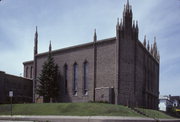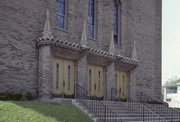| Additional Information: | A 'site file' exists for this property. It contains additional information such as correspondence, newspaper clippings, or historical information. It is a public record and may be viewed in person at the Wisconsin Historical Society, State Historic Preservation Office.
F. BARRY BYRNE DESIGNED THIS CHURCH IN A UNIQUE MELANGE OF PRAIRIE SCHOOL AND ART DECO INFLUENCES. ITS UNUSUAL DESIGN IS BELIEVED TO HAVE BEEN INSPIRED BY BYRNE'S WORK WITH FRANK LLOYD WRIGHT ON THE UNITY TEMPLE. THE BUILDING FEATURES SCULPTURES BY ALFONSO IANELLI, WHO ALSO WORKED WITH WRIGHT.
RACINE LANDMARK.
PLANS, PHOTOS AND SKETCHES OF THE CHURCH WERE EXIHIBITED AT THE ACADEMY OF FINE ARTS IN BERLIN. IT WAS SAID TO HAVE BEEN VERY INFLUENTIAL.
RELATED BUILDING: RECTORY.
FRANCIS BARRY BYRNE EARNED AN INTERNATIONAL REPUTATION FOR HIS REVOLUTIONARY DESIGNS OF CATHOLIC CHURCHES. HE BEGAN HIS ARCHITECTURAL WORK IN FRANK LLOYD WRIGHT'S OAK PARK STUDIO IN 1902, AND HE REMAINED THERE UNTIL 1908, WHEN HE LEFT TO ESTABLISH HIS OWN PRACTICE. ST PATRICK'S WAS ONLY THE SECOND CHURCH DESIGNED BY BYRNE.
With stylized lancets, soaring buttresses, and dramatic pinnacles, this striking hilltop church won popular accolades for its “American Gothic” design. But the term, stressing historical precedent, fails to capture Barry Byrne’s innovative architectural vision. Based in Chicago, Byrne was one of the most idiosyncratic practitioners of modernism. He apprenticed to Frank Lloyd Wright in the early 1900s, but his mature designs are based on principles learned from Louis Sullivan. Like Sullivan, Byrne used ornament to frame otherwise flat, unadorned, elongated wall surfaces, creating an architectural idiom all his own, blending Gothic lines with an Art Deco aesthetic.
In the 1920s, Byrne concentrated on ecclesiastical designs, and St. Patrick's ranks among his finest creations. Eschewing the usual steeple and cruciform plan, Byrne designed a square box, then slashed its flat sides with triangular shafts, which rise above the roofline as terracotta spires. The theme recurs at the building’s beveled corners, where multiple pinnacles rocket upward in tight formation. The triangles forming these spires reappear in the tall, pointed windows, the stained-glass door insets, and the terracotta coping over the doors and along the roofline. To fashion these geometric ornaments, Byrne turned to his long-time associate, sculptor Alfonso Ianelli, who once worked with Frank Lloyd Wright.
Even St. Patrick’s interior reflected Byrne’s independent mind. The nearly square sanctuary integrated the nave and sanctuary into one space to bring congregants closer to the altar and the ministration of the sacraments. The original altar, however, and the ornate reredos, which echoed the building’s stylized lancets, were removed as a result of--as some critics argue--a misinterpretation of the principles of the Second Vatican Ecumenical Council (1962-65). |
|---|
| Bibliographic References: | (A) ZIMMERMANN, RUSSELL "THE HERITAGE GUIDEBOOK" (HERITAGE BANKS 1976).
(B) AMERICAN ARCHITECT, FEB. 1926 (5 PAGES).
(C) MILWAUKEE JOURNAL, 28 MARCH 1926, SECTION 4, P. 1.
(D) SUSAN KARR, ARCHITECTURAL AND HISTORICAL SURVEY OF THE CITY OF RACINE (RACINE, WI: LANDMARKS PRESERVATION COMMISSION, 1980), 11-12.
Old Main Street Historic District Walking Tour Guide, 1990.
Buildings of Wisconsin manuscript.
Racine Landmarks Preservation Commission, Racine Frank Lloyd Wright and Prairie School Architecture Tour Guide, 1994.
Renewing Our Roots: The Northside, Racine, Wisconsin, Preservation-Racine, Inc., not dated. |
|---|





